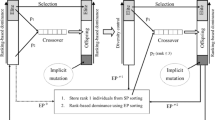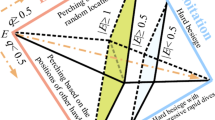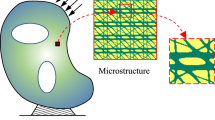Abstract
The optimal design of hybrid composite structures considering sizing, topology and material selection is addressed in a multi-objective optimization framework. The proposed algorithm, denoted by Multi-objective Hierarchical Genetic Algorithm (MOHGA), searches for the Pareto-optimal front enforcing population diversity by using a hierarchical genetic structure based on co-evolution of multi-populations. An age structured population is used to store the ranked solutions aiming to obtain the Pareto front. A self-adaptive genetic search incorporating Pareto dominance and elitism is presented. Two concepts of dominance are used: the first one denoted by local non-dominance is implemented at the isolation stage of populations and the second one called global non-dominance is considered at age structured population. The age control emulates the human life cycle and enables to apply the species conservation paradigm. A new mating and offspring selection mechanisms considering age control and dominance are adopted in crossover operator applied to age-structured population. Application to hybrid composite structures requiring the compromise between minimum strain energy and minimum weight is presented. The structural integrity is checked for stress, buckling and displacement constraints considered in the multi-objective optimization. The design variables are ply angles and ply thicknesses of shell laminates, the cross section dimensions of beam stiffeners and the variables associated with the material distribution at laminate level and structure level. The properties of the proposed approach are discussed in detail.














Similar content being viewed by others
References
António CC, Hoffbauer LN (2009) An approach for reliability-based robust design optimisation of angle-ply composites. Compos Struct 90:53–59
Awad ZK, Aravinthan T, Zhuge Y, Gonzalez F (2012) A review of optimization techniques used in the design of fibre composite structures for civil engineering applications. Mater Des 33:534–544
Baier H, Huber M, Langer H (2008) Design optimization of hybrid material structures. Struct Multidisc Optim 36:203–213
Budiansky B (1974) Theory of buckling and post-buckling of elastic structures. Adv Appl Mech 14:2–63
Chun J-S, Kim M-K, Jung H-K (1997) Shape optimization of electromagnetic devices using Immune Algorithm. IEEE Trans Magnet 33:1876–1879
Conceição António CA (2002) A multilevel genetic algorithm for optimization of geometrically non-linear stiffened composite structures. Struct Multidisc Optim 24:372–386
Conceição António CA (2006) A hierarchical genetic algorithm with age structure for multimodal optimal design of hybrid composites. Struct Multidisc Optim 31:280–294
Conceição António C (2009a) Self-adaptation procedures in genetic algorithms applied to the optimal design of composite structures. Int J Mech Mater Des 5:289–302
Conceição António CA (2009b) A study on synergy of multiple crossover operators in a hierarchical genetic algorithm applied to structural optimization. Struct Multidisc Optim 38:117–135
Conceição António CA, Torres Marques A, Soeiro AV (1995) Optimization of laminated composite structures using a bilevel strategy. Compos Struct 33:193–200
Conceição António CA, Trigo Barbosa J, Simas Dinis L (2000) Optimal design of beam reinforced composite structures under elasto-plastic loading conditions. Struct Multidiscipl Optim 19:50–63
Crisfield MA (1997) Non-linear finite element analysis of solids and structures, vol 2. Wiley, Chichester
Deb K (2001) Multi-objective optimization using evolutionary algorithms. Wiley, Chichester
Fonseca CM, Fleming PJ (1993) Genetic algorithms for multi-objective optimization: formulation, discussion and generalization. In: Forrest S(ed) Proceedings of the fifth international conference on genetic algorithms, San Mateo, California, University of Illinois at Urbana-Champaign. Morgan Kauffman Publishers, San Francisco, pp 416–423
Ghiasi H, Pasini D, Lessard L (2010) Pareto frontier for simultaneous structural and manufacturing optimization of composite part. Struct Multidisc Optim 40:497–511
Irisarri F-X, Laurin F, Leroy FH, Maire J-F (2011) Computational strategy for multiobjective optimization of composite stiffened panels. Compos Struct 93:1158–1167
Kassapoglou C, Dobyns AL (2001) Simultaneous cost and weight minimization of postbuckled composite panels under combined compression and shear. Struct Multidisc Optim 21:372–382
Li M, Kou J (2008) Crowding with nearest neighbours replacement for multiple species niching and building blocks preservation in binary multimodal functions optimization. J Heurist 14:243–270
Murugan MS, Suresh S, Ganguli R, Mani V (2007) Target vector optimization of composite box beam using real-coded genetic algorithm: a decomposition approach. Struct Multidisc Optim 33:131–146
Pelletier JL, Vel SS (2006) Multi-objective optimization of fiber reinforced composite laminates for strength, stiffness and minimal mass. Comput Struct 84:2065–2080
Rahul Sandeep, G, Chakraborty D, Dutta A (2006) Multi-objective optimization of hybrid laminates subjected to transverse impact. Compos Struct 73:360–369
Siarry P, Pétrowski A, Bessaou M (2002) A multipopulation genetic algorithm aimed at multimodal optimization. Adv Eng Softw 33:207–213
Spears WM, DeJong SK (1991) On the virtues of parameterized uniform crossover. In: Belew RK, Booker LB(eds) Proceedings of the fourth international conference on genetic algorithms. Morgan Kaufmann, San Mateo, pp 230–236
Tang XG, Bassir DH, Zhang WH (2010) Shape, sizing optimization and material selection based on mixed variables and genetic algorithm. Optim Eng 12:111–128
Tsai SW (1987) Composites design. Think composites. Dayton, USA
Wang K, Kelly D, Dutton S (2002) Multi-objective optimisation of composite aerospace structures. Compos Struct 57:141–148
Acknowledgment
The authors acknowledge the financial support provided by the Foundation for Science and Technology (FCT), Portugal, through the strategic project PEst-OE/EME/UI0225/2011.
Author information
Authors and Affiliations
Corresponding author
Rights and permissions
About this article
Cite this article
Conceição António, C.A. Local and global Pareto dominance applied to optimal design and material selection of composite structures. Struct Multidisc Optim 48, 73–94 (2013). https://doi.org/10.1007/s00158-012-0878-1
Received:
Accepted:
Published:
Issue Date:
DOI: https://doi.org/10.1007/s00158-012-0878-1




